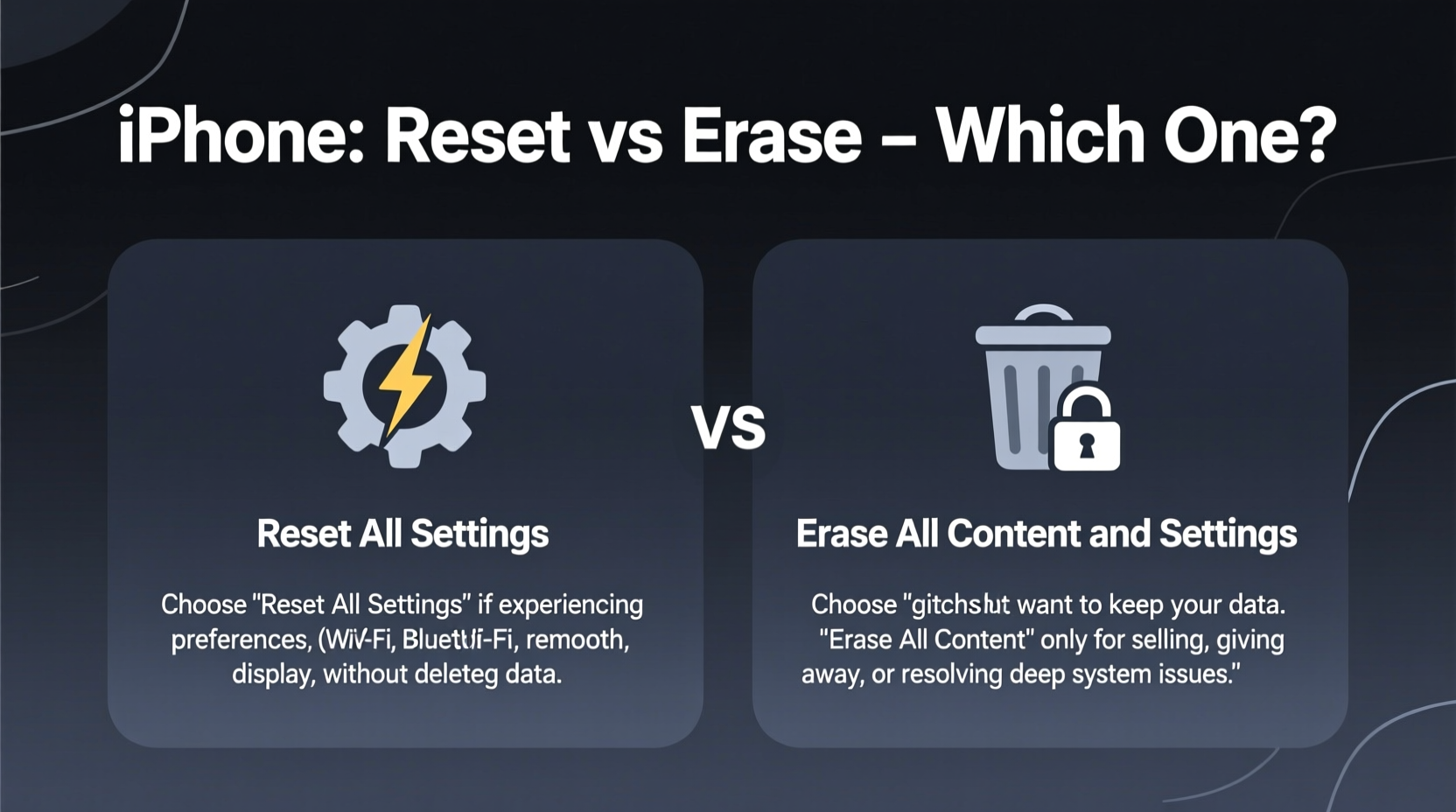Your iPhone may start behaving strangely over time: apps crashing, Wi-Fi dropping, battery draining fast, or settings not saving. When troubleshooting fails, Apple offers two powerful options under Settings > General > Transfer or Reset iPhone: Reset All Settings and Erase All Content and Settings. While they sound similar, they have vastly different consequences. Choosing the wrong one could mean losing precious photos, messages, or app data. Understanding the distinction is critical before taking action.
What Happens When You Reset All Settings?

Resetting all settings returns your iPhone’s system preferences to factory defaults—but it does not delete personal data like photos, messages, contacts, or apps. This option clears:
- Wi-Fi passwords and saved networks
- Bluetooth pairings (e.g., with car systems or headphones)
- Display brightness, wallpaper, and text size
- Privacy permissions for apps
- Location services, analytics, and advertising settings
- Keyboard dictionary and predictive text learning
- VPN and APN configurations
This reset is ideal if you're experiencing connectivity issues, display glitches, or erratic behavior tied to misconfigured preferences. It's a middle-ground fix—more thorough than restarting, but far less drastic than wiping everything.
What Happens When You Erase All Content and Settings?
This option performs a full factory reset. Everything on the device—apps, messages, photos, videos, music, documents, and settings—is permanently deleted. The phone reverts to its out-of-the-box state, just as if it were brand new.
You’ll need to:
- Re-enter your Apple ID and password
- Set up Face ID or Touch ID again
- Restore from a backup or set up as new
- Re-download apps and sign back into accounts
Apple recommends this step only when selling your device, switching to a new phone, or when serious software corruption persists after other fixes fail.
“Erase All Content and Settings should never be your first troubleshooting step. It’s a last resort when diagnostics point to deep-seated OS-level corruption.” — Jordan Lee, Senior iOS Support Analyst at Apple Authorized Service Provider
Reset All Settings vs Erase All Content: Key Differences
| Feature | Reset All Settings | Erase All Content and Settings |
|---|---|---|
| Personal Data (Photos, Messages) | ✅ Preserved | ❌ Deleted |
| Apps and App Data | ✅ Kept installed | ❌ Removed |
| Wi-Fi & Bluetooth Connections | ❌ Cleared | ❌ Cleared |
| Apple ID & iCloud Login | ✅ Remains logged in | ⚠️ Requires re-login |
| Setup Time After Reset | ⏱️ Minimal (few minutes) | ⏱️ Extended (30+ mins with restore) |
| Best For | Fixing bugs, connectivity, UI issues | Selling phone, major crashes, malware |
Step-by-Step: How to Choose and Execute the Right Reset
- Assess the Problem: Is it a visual glitch, network drop, or constant app crash? Try restarting first.
- Back Up Your iPhone: Use iCloud or iTunes/Finder to create a current backup—even if doing Reset All Settings.
- Navigate to Reset Menu: Go to Settings > General > Transfer or Reset iPhone.
- Select Based on Symptoms:
- If Wi-Fi keeps disconnecting → Reset All Settings
- If screen freezes after update → Reset All Settings
- If selling or giving away phone → Erase All Content and Settings
- If stuck on Apple logo or boot loop → Erase All Content and Settings via recovery mode
- Confirm and Wait: The process takes 1–10 minutes. Do not interrupt power or connection.
- Restore or Reconfigure: After Erase, restore from backup. After Reset Settings, reconfigure Wi-Fi and privacy options.
Real-World Example: Sarah’s Overheating iPhone
Sarah noticed her iPhone 13 was overheating during calls and draining battery in half a day. She tried closing apps and lowering brightness, but the issue persisted. She considered erasing everything but hesitated—her daughter’s first-year photos were on the phone.
Instead, she backed up to iCloud, then chose Reset All Settings. Afterward, she reconnected to Wi-Fi and paired her AirPods again. To her surprise, the phone cooled down immediately, and battery life improved. Later, she discovered a rogue background app refresh setting had been causing excessive activity. The reset cleared that without touching her photos.
Sarah avoided irreversible data loss by choosing the lighter reset first—proving that methodical troubleshooting pays off.
Checklist: Before You Reset Your iPhone
- ✅ Back up to iCloud or computer
- ✅ Charge your iPhone to at least 50%
- ✅ Note down important Wi-Fi passwords
- ✅ Disable Find My iPhone (if erasing)
- ✅ Ensure you know your Apple ID and password
- ✅ Decide: Fix settings or wipe clean?
- ✅ Choose the correct reset option
Frequently Asked Questions
Will Reset All Settings delete my WhatsApp chats?
No. Reset All Settings does not remove app data, including WhatsApp messages stored locally. However, if you rely on iCloud backups for WhatsApp, ensure one exists before any reset.
Can I recover data after Erase All Content and Settings?
Only if you have a recent backup. Once erased, data is unrecoverable without a backup from iCloud or a computer. Always verify your last backup date before proceeding.
Why didn’t Reset All Settings fix my problem?
If system-level corruption or a faulty app installation is the root cause, deeper intervention may be needed. Try updating iOS first. If problems continue, a full erase and restore might be necessary.
Conclusion: Make the Smart Choice for Your iPhone’s Health
When your iPhone acts up, panic can lead to rash decisions. But understanding the real impact of Reset All Settings versus Erase All Content and Settings puts you in control. In most cases, Reset All Settings is the smarter first move—it clears problematic configurations while preserving your memories and data. Reserve the full erase for device handoffs or persistent failures unresponsive to updates and restarts.
Always back up, always assess symptoms carefully, and never skip the simpler fix in favor of the nuclear option. Your iPhone—and your peace of mind—will thank you.









 浙公网安备
33010002000092号
浙公网安备
33010002000092号 浙B2-20120091-4
浙B2-20120091-4
Comments
No comments yet. Why don't you start the discussion?